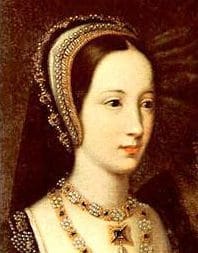 On this day in 1496, Henry VIII’s beloved sister, Princess Mary Tudor, was born at Richmond Palace. She was the youngest of Henry VII’s and Elizabeth of York’s children to survive infancy, and was sister to Prince Arthur, Princess Margaret and Prince Henry.
On this day in 1496, Henry VIII’s beloved sister, Princess Mary Tudor, was born at Richmond Palace. She was the youngest of Henry VII’s and Elizabeth of York’s children to survive infancy, and was sister to Prince Arthur, Princess Margaret and Prince Henry.
Mary was renowned for her beauty, being described as “a Paradise – tall, slender, grey-eyed, possessing an extreme pallor” by the Venetian ambassador, and her motto was La volenté de Dieu me suffit (The will of God is sufficient for me).
In 1507, Mary was betrothed to Charles of Castile (the future Charles V Holy Roman Emperor), and their wedding was planned for 1514. However, the betrothal was cancelled due to Henry VIII’s diplomatic dealings and, much to Mary’s horror, she was betrothed instead to the fifty-two year-old King Louis XII of France, a man thirty-four years her senior, as part of Cardinal Wolsey’s peace treaty with France.
Mary married King Louis XII of France in Abbeville on 9th October 1514 when she was just eighteen, but the marriage was short-lived, with the King dying just a few months later, on 1st January 1515. Mary had been in love with Charles Brandon, Duke of Suffolk and a great friend of Henry VIII, and before her marriage to Louis XII she had made her brother promise that if she married the French King and outlived him, that she could choose her next husband.
Mary was kept isolated from men for six weeks at the Palais de Cluny to see if she was carrying the heir to the French throne, but then her real love, Charles Brandon, was sent to France to escort her home. Mary and Charles Brandon took a huge risk by secretly marrying in France on 3rd March 1515,* without the King’s permission, something which could be classed as treason. Henry VIII was furious but his love for his favourite sister and his friendship with Brandon led to him forgiving the couple, and they were officially married at Greenwich Palace, 13th May 1515. Although she was now the Duchess of Suffolk, Mary was still referred to as the “French Queen”.
Mary had four children by Charles Brandon, the Duke of Suffolk, but only two daughters, Frances and Eleanor, survived childhood. Frances married Henry Grey, Marquis of Dorset, and was the mother of Lady Jane Grey. Eleanor married Henry Clifford, the 2nd Earl of Cumberland.
Mary became ill in 1533, and died on 25th June (some sources say 24th) at Westhorpe, Suffolk. She was laid to rest in the abbey at Bury St Edmunds, Suffolk, and then moved to St Mary’s Church in Bury St Edmunds during the Dissolution of the Monasteries.
*It is thought that they married in secret in mid February and that this was then followed by a further ceremont in France. A French chronicle gives the date of 3rd March 1515 and Louise of Savoy gives the date of 31st March 1515.
(Taken from On this Day in Tudor History by Claire Ridgway.)
You can read more about Mary in the following articles:
- Katherine of Aragon or Mary Tudor? – The Re-identification of Michel Sittow’s Portrait of a Young Woman by Nasim Tadghighi
- Princess Mary Tudor
- Mary Tudor Marries Louis XII of France
- Death of Mary Tudor Queen of France
